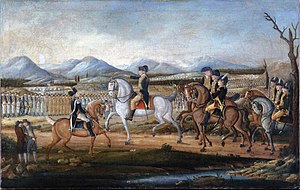Whiskey Rebellion
The Whiskey Rebellion was a rebellion against the federal government of the United States. Some farmers in western Pennsylvania rebelled against the United States government in 1794 because they believed that a new tax on whiskey was not fair. Selling whiskey was how people traded in western Pennsylvania, but farmers elsewhere did not need to sell whiskey.

The United States had borrowed a large amount of money for the American Revolutionary War, and Alexander Hamilton offered the idea to try to pay the war debt. The government under George Washington, with advice from Alexander Hamilton, quickly stopped the rebellion. Washington and Hamilton wanted to ensure that no one would question the power of the federal government and so Washington himself led almost 13,000 troops to stop the rebellion of a few hundred farmers. The rebels went home before the army arrived.
The new federal government became more solid and the president more powerful.[1] Numerous examples of resistance are recorded in court documents and newspaper accounts.[2]
That is the only time in American history that a president has led the army by himself.
References
change